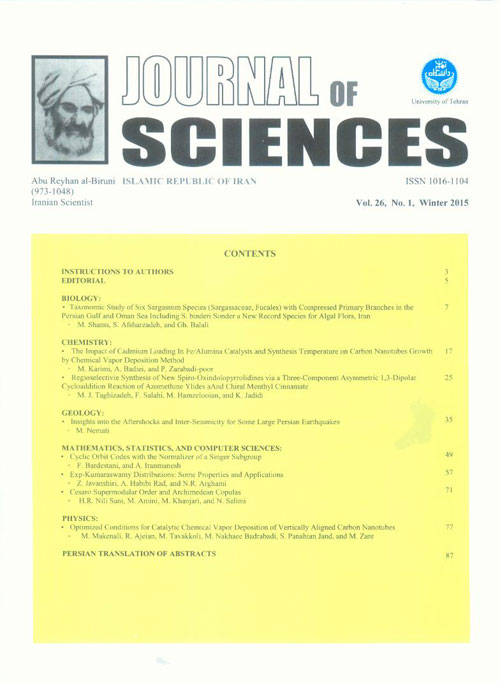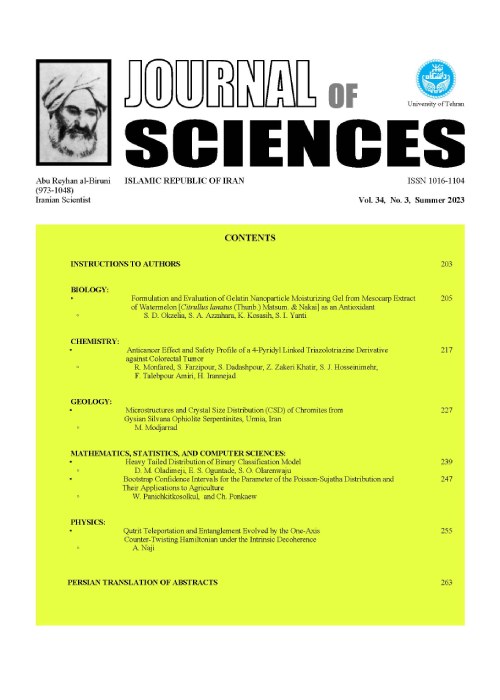فهرست مطالب

Journal of Sciences, Islamic Republic of Iran
Volume:26 Issue: 1, Winter 2015
- تاریخ انتشار: 1393/12/24
- تعداد عناوین: 8
-
-
صفحات 49-55
-
صفحات 57-69
-
صفحات 71-76
-
Pages 7-16Six species of Sargassum C. Agardh (Sargassaceae) with compressed primary branches, including: S. binderi Sonder, S. aquifolium (Turner)C. Agardh, S. oligocystum Montagne, S. swartzii (Turner)C. Agardh, S. crassifolium J. Agardh and S. cristaefolium C. A. Agardh, were identified in the Persian Gulf and Oman Sea coasts, among which S. binderi is reported as newly recorded species in Iran for the first time. The specimens were collected from 15 stations along the Iranian southern shores in the autumn, winter and spring from 2010 to 2012. Anatomical and morphological studies were performed according to the valid identification keys. In taxonomy studies, 47 quantitative and qualitative morphological characters were selected. In order to analyze of data, clustering analysis was performed by UPGMA and PCA analyses. The results revealed that there were more qualitative than quantitative traits in species identification. The shape of receptacles, leaves, vesicles and stems were the most diagnostic characteristics in the species identification. The species including: S. binderi, S. crassifolium and S. cristaefolium have flattened triangular receptacles; while S. crassifolium and S. cristaefolium have duplicated leaves with fine teeth; S. swartzii has linear lanceolate leaves, pointed or crowned vesicles and S. oligocystum has broader lanceolate leaves with an acute to rounded apex, and often entire and spherical vesicles. S. oligocystum and S. crassifolium belong to the section Acanthocarpicae. Also, S. cristaefolium belongs to section Sargassum and S. binderi, S. aquifolium and S. swartzii belong to section Binderianeae.Keywords: Sargassum, Persian Gulf, Oman Sea, Phaeophyta, Compressed branches, Iran
-
Pages 17-24We evaluated the effect of Fe/Alumina Catalyst contained different Cadmium contents and two synthesis temperatures on producing carbon nanotubes by chemical vapor deposition of methane as a feedstock. X-ray powder diffraction (XRD), N2 adsorption-desorption, scanning electron microscopy (SEM), transmission electron microscopy (TEM), Raman spectroscopy and Thermogravimetry analysis (TGA) were used for characterizing of synthesized catalysts and carbon nanotubes. Raman spectrum confirmed the presence of carbon nanotubes. TGA showed larger deposited carbon nanotubes in certain cadmium contents and higher synthesis temperature of 950 °C. Based on morphological assessment in SEM images, the increase in cadmium content leads to the decrease in diameter of resulted carbon nanotubes.Keywords: Carbon nanotube, CVD, Methane, Cadmium, Fe, Alumina
-
Pages 25-33An efficient, one-pot, four-component procedure for the synthesis of a small library of new chiral spiro- oxindolopyrrolidines with high regio-, diastereo- (>99:1 dr), and enantioselectivity (up to 80% ee) is described. In this process, the regio- and stereochemical 1,3-dipolar cycloaddition of azomethine ylides, which were generated insitu by the reaction of isatin derivatives and sarcosin,with optically active chiral menthyl cinnamate studied on the basis of the assignment of the absolute configuration of the cycloadducts, and on theoretical calculations. In comparison with active cinnamoyl oxazolidinone, when the reactions were performed with active chiral menthyl cinnamate as dipolarophile, a remarkable unexpected inversion in the regioselectively was observed. The regioselectivity of the reactions was investigated using global and local reactivity indices at the B3LYP/6-311G(d,p) level of theory. The effects of the electronic and steric factors on the regioselectivity of the reactions were discussed. The electronic structures of critical points were studied by the natural bond orbital (NBO) method.Keywords: Chiral spiro, oxindolopyrrolidines, Asymmetric 1, 3, dipolar, Chiral auxiliaries
-
Pages 35-48This paper focuses on aftershocks behavior and seismicity along some co-seismic faults for large earthquakes in Iran. The data of aftershocks and seismicity roughly extracted from both the Institute of Geophysics the University of Tehran (IGUT) and International Seismological Center (ISC) catalogs. Apply some essential methods on 43 large earthquakes data; like the depth, magnitude as well as the aftershock data; resulted knowledge about some relations between earthquake characteristics. We found ~16.5km for deep seated co-seismic fault length for the 2005 Dahouieh Zarand earthquake (MW 6.4) considering the dimension of the main cluster of aftershocks. Moreover, a slightly decrease in aftershocks activity was observed with increase in depth of the mainshocks for some Iranian earthquakes. Also the clustered aftershocks for the 1997 Zirkuh-e Qaen earthquake (MW 7.1) showed a clear decrease in maximum magnitude of the aftershocks per day elapsed from mainshock. Finally, we could explore an anti-correlation between aftershocks distribution and post microseismicity along co-seismic faults for both Dahouieh and Qaen earthquakes.Keywords: Aftershock, Mainshock, Magnitude, Seismicity, Persia
-
Pages 49-55An algebraic construction for constant dimension subspace codes is called orbit code. It arises as the orbits under the action of a subgroup of the general linear group on subspaces in an ambient space. In particular orbit codes of a Singer subgroup of the general linear group has investigated recently. In this paper, we consider the normalizer of a Singer subgroup of the general linear group and its orbit codes. Several properties of these codes are considered.Keywords: Linear network coding, Constant dimension codes, Group action, Orbit codes
-
Pages 57-69In this paper, we propose and study exp-kumaraswamy distribution. Some of its properties are derived, including the density function, hazard rate function, quantile function, moments, skewness and kurtosis. Adata set isused to illustrate an application of the proposed distribution. Also, we obtain a new distribution by transformation onexp-kumaraswamy distribution. New distribution is an alternative to skew-normal distribution. Basic properties ofthis new distribution, such as moment generating function, moments, skewness, kurtosis and maximum likelihood estimation are studied. Its applicability is illustrated by means of two real data sets.Keywords: Log, exp, kumaraswamy distribution, Moments, Moment generating function, Kurtosis, Skewness
-
Pages 71-76In this paper, we introduce a new kind of order, Cesaro supermodular order, which includes supermodular order and stochastic order. For this new order, we show that it almost fulfils all desirable properties of a multivariate positive dependence order that have been proposed by Joe (1997). Also, we obtain some relations between it with other orders. Finally, we consider different issues related extended Archimedean copula and positive dependence.Keywords: Stochastic order, Supermodular order, Positive dependent random variables, Cesaro supermodular order, Archimedean copula
-
Pages 77-85Here, we have synthesized vertically aligned carbon nanotubes (VA-CNTs), using chemical vapor deposition (CVD) method. Cobalt and ethanol are used as the catalyst and the carbon source, respectively. The effects of ethanol flow rate, thickness of Co catalyst film, and growth time on the properties of the carbon nanotube growth are investigated. The results show that the flow rate of ethanol and the Co layer thickness play important roles on the length and the degree of alignment of the carbon nanotubes. High density VA-CNTs with forest-like structure are grown at a very low ethanol flow rate of 0.8 sccm, which is the optimized flow rate in our experiments. Therefore, the cost of synthesizing VA-CNTs is decreased by a low consumption of ethanol and utilizing the cheap CVD synthesis method. High density of small-sized catalyst particles is formed in the Co-catalyst thickness of 1 and 2nm, resulting in the growth of vertically aligned nanotubes. However, increasing the thickness of Co layer to 10 and 16 nm, leads to the growth of nanotubes parallel to the substrate with the spaghetti-like structure. The experiments reveal that enhancing the growth time from 5 to 120 min can mostly affect the uniformity and length of VA-CNTs.Keywords: Vertically aligned carbon nanotubes, Ethanol flow rate, Co catalyst thickness, Growth time


